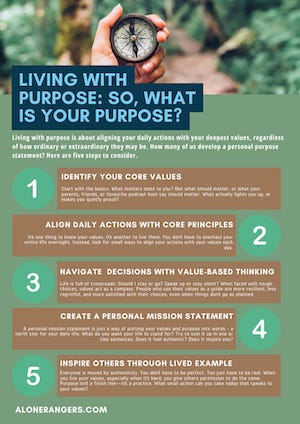Living with Purpose: So, What is Your Purpose? (With Infographic)
Living with purpose is about aligning your daily actions with your deepest values. But how do we find that “why”? How do we live it? Here are my 5 steps to creating your own purpose.
This is the follow-up to my article ‘Living with Purpose: A Guide for the Beautifully Lost’.
Ironically, as I began work on this article, with all my business experience at hand, I realised I am not actually clear on my own purpose.
Living with purpose isn’t about being perfect, impressive, or endlessly productive. It doesn’t mean you have to be saving whales, climbing Everest, or launching a tech startup before breakfast (ahem, the latter being what I have now done several times with varying success).
Living with purpose is about aligning your daily actions with your deepest values, regardless of how ordinary or extraordinary they may be.
It’s about being honest—first with yourself, then with the world. It’s about showing up, even when you’re not sure you have the answers. It’s about finding meaning in the small things and letting your values guide you through the messiness of modern life.
But how do we find that “why”? And, perhaps more importantly, how do we live it?
Step 1: Identify Your Core Values
If you’ve ever tried to assemble IKEA furniture without the manual, you know the value of clear instructions. The same goes for life. Your values are the instruction manual, except you get to write it yourself.
Start with the basics. What matters most to you? Not what should matter, or what your parents, friends, or favourite podcast host say should matter. What actually lights you up, or makes you quietly proud? Psychologists call these “signature strengths.” The VIA Institute on Character suggests that identifying your core values is the first step toward a more purposeful life.
Celebrities are often caricatured as shallow, but many have publicly wrestled with purpose. Take Michelle Obama, who has spoken about the importance of authenticity:
"Success is only meaningful and enjoyable if it feels like your own."
Or Keanu Reeves, whose quiet generosity and humility off-screen have become legendary. He’s not living for the headlines, he’s living for what feels right to him - and yes, I want to be Keanu Reeves when I grow up.
Step 2: Align Daily Actions with Core Principles
It’s one thing to know your values. It’s another to live them—especially when the Wi-Fi is down, you are running a 39.7 degree temperature, and your daughter just emptied a two-litre carton of milk on her bedroom floor (my life this week). You don’t have to overhaul your entire life overnight. Instead, look for small ways to align your actions with your values each day.
If you value kindness: Send a thoughtful message to a friend.
If you value creativity: Spend ten minutes doodling, writing, or playing music.
If you value honesty: Speak up (gently) when something doesn’t sit right.
Step 3: Navigate Difficult Decisions Through Value-Based Thinking
Life is full of crossroads: Should I stay or go? Speak up or stay silent? Make a ham and cheese toastie or a protein shake for breakfast - the latter is always my intent, the former the reality. When faced with tough choices, values act as a compass. Ask yourself:
Which option is most aligned with my core values?
What would my “best self” do here?
Will I be proud of this decision tomorrow, or in ten years?
Research from the Big Self School suggests that people who use their values as a guide are more resilient, less regretful, and more satisfied with their choices, even when things don’t go as planned.
Actor Denzel Washington once said:
"At the end of the day, it’s not about what you have or even what you’ve accomplished. It’s about what you’ve done with those accomplishments. It’s about who you’ve lifted up, who you’ve made better. It’s about what you’ve given back."
That’s value-based decision-making in action.
Step 4: Create a Personal Mission Statement
As someone who has written any number of corporate strategy documents over the decades, the idea of writing a mission statement generally makes me groan. For others, I appreciate it can feel intimidating, but it doesn’t have to be. A personal mission statement is just a way of putting your values and purpose into words - a north star for your daily life.
Reflect: What do you want your life to stand for?
Condense: Try to sum it up in one or two sentences.
Test: Does it feel authentic? Does it inspire you?
I’ve now realised the notes I jotted a couple of years ago about the life I want to lead are the bones of my own mission statement. I will continue to refine my understanding of my mission and purpose.
I rather like Richard Branson’s: “To have fun in my journey through life and learn from my mistakes.”. Steve Jobs once said in an interview, “to make a dent in the universe”.
Notice none of these are long. They are simply expressions of their core values and how they perceive their purpose in the world. You are not writing an essay!
Step 5: Inspire Others Through Lived Example
Here’s a secret: nobody likes a lecture. But everyone is moved by authenticity.
You don’t have to be perfect. You just have to be real. When you live your values, especially when it’s hard, you give others permission to do the same.
Consider the late Chadwick Boseman, who quietly battled cancer while filming Black Panther and other movies. He didn’t often discuss his struggles, but his strength, dignity, and dedication inspired millions. Purpose doesn’t always shout. Sometimes, it’s a quiet, steady presence.
Or Greta Thunberg, who began with a solo school strike for climate action. She didn’t wait for permission; she just acted on her values, and the world noticed.
Or Chanel Contos, the Australian former schoolgirl who became known globally in 2021, following an outpouring of responses to her request for young Australian women to report on their sexual assault experiences. She’s now changing the world as an author, advocate and the founder of Teach Us Consent.
Purpose isn’t a finish line, it’s a practice. What small action can you take today that speaks to your values?
Download this quick checklist infographic :)



